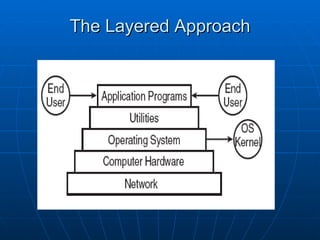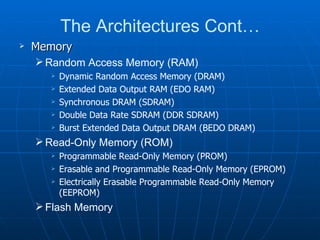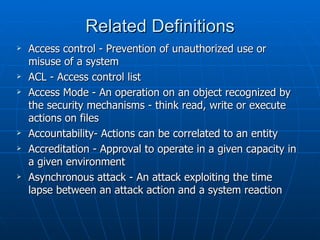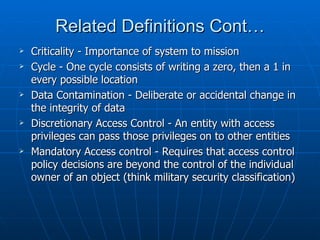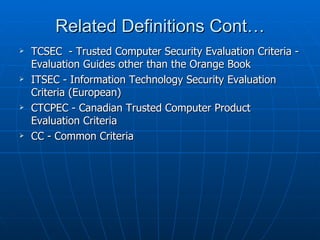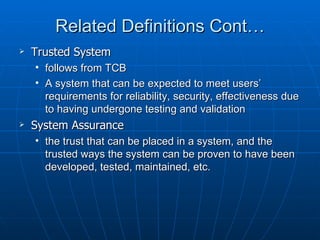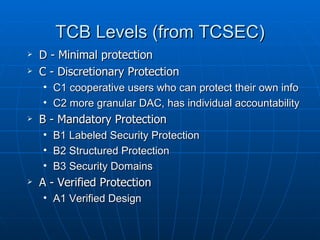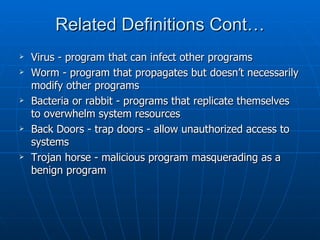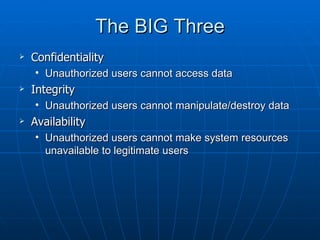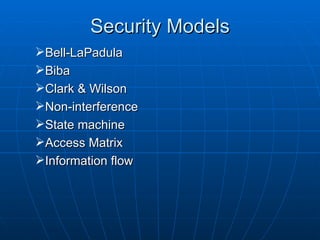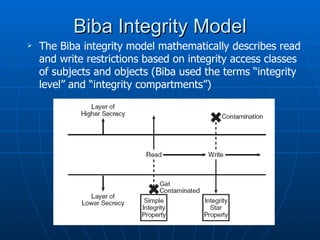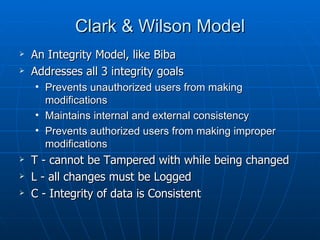3. security architecture and models
- 1. Security Architecture and Models
- 2. Security Architecture and Models Security models in terms of confidentiality, integrity, and information flow Differences between commercial and government security requirements The role of system security evaluation criteria such as TCSEC, ITSEC, and CC Security practices for the Internet (IETF IPSec) Technical platforms in terms of hardware, firmware, and software System security techniques in terms of preventative, detective, and corrective controls
- 4. The Architectures Platform Architecture Operating System Software and Utilities Central Processing Unit (CPU) States Memory Management Overview Input/Output Devices Storage Devices • Operating System Multitasking - Systems allow a user to perform more than one computer Task, such as the operation of an application program at the same time Multithreading - The ability of a program or an operating system process to manage its use by more than one user at a time and to even manage multiple requests by the same user without having to have multiple copies of the programming running in the computer
- 5. The Architectures Cont… Operating System • Multiprogramming system - System that allows for the interleaved execution of two or more programs by a processor • Multiprocessing - The coordinated processing of two or more programs by a processor that contains parallel processors CPU States • Run - The CPU is executing instructions for the current process • Wait - The process is waiting for a defined event to occur, such as retrieving data from a hard disk • Sleep - The process is suspended and waiting for its next time slice in the CPU, or a given event to occur such as an alarm • Masked/interruptible state - Interrupts are implemented to allow system events to be synchronized. For example, if the masked bit is not set, the interruption is disabled (masked off)
- 6. The Architectures Cont… Memory Random Access Memory (RAM) Dynamic Random Access Memory (DRAM) Extended Data Output RAM (EDO RAM) Synchronous DRAM (SDRAM) Double Data Rate SDRAM (DDR SDRAM) Burst Extended Data Output DRAM (BEDO DRAM) Read-Only Memory (ROM) Programmable Read-Only Memory (PROM) Erasable and Programmable Read-Only Memory (EPROM) Electrically Erasable Programmable Read-Only Memory (EEPROM) Flash Memory
- 7. The Architectures Cont… Storage • Primary - Main memory directly accessible to the CPU • Secondary - Nonvolatile storage medium • Real - A program is given a definite storage location in memory • Virtual - The ability to extend the apparent size of RAM • Volatile - RAM • Nonvolatile – ROM and Secodary storage devices • Write-Once Read Memory -
- 8. The Architectures Cont… Network Environment - A data communication system allowing a number of devices to communicate with each other • Local Environment • Shared Environment • Security Environments • Dedicated security mode -processing of one particular type or classification of information • System high-security mode – system hardware/software is only trusted to provide need-to-know protection between users • Multi-level security mode - allows two or more classification levels • Controlled mode - type of multi-level security in which a more limited amount of trust • Compartmentalized security mode - process two or more types of compartmented information Enterprise Architecture - Systematically derived and captured structural descriptions
- 9. Related Definitions Access control - Prevention of unauthorized use or misuse of a system ACL - Access control list Access Mode - An operation on an object recognized by the security mechanisms - think read, write or execute actions on files Accountability- Actions can be correlated to an entity Accreditation - Approval to operate in a given capacity in a given environment Asynchronous attack - An attack exploiting the time lapse between an attack action and a system reaction
- 10. Related Definitions Cont… Audit trail - Records that document actions on or against a system Bounds Checking - Within a program, the process of checking for references outside of declared limits. When bounds checking is not employed, attacks such as buffer overflows are possible Compartmentalization - Storing sensitive data in isolated blocks Configuration Control - management and control of changes to a system’s hardware, firmware, software, and documentation confinement - Ensuring data cannot be abused when a process is executing a borrowed program and has some access to that data
- 11. Related Definitions Cont… Contamination – Corruption of data of varying classification levels Correctness Proof - Mathematical proof of consistency between a specification and implementation Countermeasure - anything that neutralizes vulnerability Covert Channel - A communication channel that allows cooperating processes to transfer information in a way that violates a system’s security policy • covert storage channel involves memory shared by processes • covert timing channel involves modulation of system resource usage (like CPU time)
- 12. Related Definitions Cont… Criticality - Importance of system to mission Cycle - One cycle consists of writing a zero, then a 1 in every possible location Data Contamination - Deliberate or accidental change in the integrity of data Discretionary Access Control - An entity with access privileges can pass those privileges on to other entities Mandatory Access control - Requires that access control policy decisions are beyond the control of the individual owner of an object (think military security classification)
- 13. Related Definitions Cont… DoD Trusted Computer System Evaluation Criteria (TCSEC) - orange book Firmware - software permanently stored in hardware device (ROM, read only memory) Formal Proof - Mathematical argument Hacker/Cracker – Individual who cause Damage Logic bomb - An unauthorized action triggered by a system state Malicious logic - Evil hardware, software, or firmware included by malcontents for malcontents
- 14. Related Definitions Cont… Principle of Least Privilege - Every entity granted least privileges necessary to perform assigned tasks Memory bounds - The limits in a range of storage addresses for a protected memory region Piggy Back - Unauthorized system via another’s authorized access (shoulder surfing is similar) Privileged Instructions - Set of instructions generally executable only when system is operating in executive state Reference Monitor - A security control which controls subjects’ access to resources - an example is the security kernel for a given hardware base
- 15. Related Definitions Cont… Resource - Anything used while a system is functioning (eg CPU time, memory, disk space) Resource encapsulation - Property which states resources cannot be directly accessed by subjects because subject access must be controlled by the reference monitor Security Kernel - Hardware/software/firmware elements of the Trusted Computing Base - security kernel implements the reference monitor concept Trusted Computing Base - From the TCSEC, the portion of a computer system which contains all elements of the system responsible for supporting the security policy and supporting the isolation of objects on which the protection is based -follows the reference monitor concept
- 16. Related Definitions Cont… TCSEC - Trusted Computer Security Evaluation Criteria - Evaluation Guides other than the Orange Book ITSEC - Information Technology Security Evaluation Criteria (European) CTCPEC - Canadian Trusted Computer Product Evaluation Criteria CC - Common Criteria
- 17. Related Definitions Cont… Trusted System • follows from TCB • A system that can be expected to meet users’ requirements for reliability, security, effectiveness due to having undergone testing and validation System Assurance • the trust that can be placed in a system, and the trusted ways the system can be proven to have been developed, tested, maintained, etc.
- 18. TCB Levels (from TCSEC) D - Minimal protection C - Discretionary Protection • C1 cooperative users who can protect their own info • C2 more granular DAC, has individual accountability B - Mandatory Protection • B1 Labeled Security Protection • B2 Structured Protection • B3 Security Domains A - Verified Protection • A1 Verified Design
- 19. Related Definitions Cont… Virus - program that can infect other programs Worm - program that propagates but doesn’t necessarily modify other programs Bacteria or rabbit - programs that replicate themselves to overwhelm system resources Back Doors - trap doors - allow unauthorized access to systems Trojan horse - malicious program masquerading as a benign program
- 21. General Operating System Protection User identification and authentication Mandatory access control Discretionary access control Complete mediation Object reuse protection Audit Protection of audit logs Audit log reduction Trusted path Intrusion detection
- 22. Network Protection Hash totals Recording of sequence checking Transmission logging Transmission error correction Invalid login, modem error, lost connections, CPU failure, disk error, line error, etc. Retransmission control
- 23. The BIG Three Confidentiality • Unauthorized users cannot access data Integrity • Unauthorized users cannot manipulate/destroy data Availability • Unauthorized users cannot make system resources unavailable to legitimate users
- 24. Security Models Bell-LaPadula Biba Clark & Wilson Non-interference State machine Access Matrix Information flow
- 25. Bell-LaPadula A state machine model capturing the confidentiality aspects of access control
- 26. Biba Integrity Model The Biba integrity model mathematically describes read and write restrictions based on integrity access classes of subjects and objects (Biba used the terms “integrity level” and “integrity compartments”)
- 27. Clark & Wilson Model An Integrity Model, like Biba Addresses all 3 integrity goals • Prevents unauthorized users from making modifications • Maintains internal and external consistency • Prevents authorized users from making improper modifications T - cannot be Tampered with while being changed L - all changes must be Logged C - Integrity of data is Consistent
- 28. Clark & Wilson Model Cont… Proposes “Well Formed Transactions” • perform steps in order • perform exactly the steps listed • authenticate the individuals who perform the steps Calls for separation of duty Well-formed transaction - The process and data items can be changed only by a specific set of trusted programs
- 29. More Models Access matrix model - A state machine model for a discretionary access control environment Information flow model - simplifies analysis of covert channels • A variant of the access control model • Attempts to control the transfer of information from one object into another object • helps to find covert channels
- 30. More Models Cont… Noninterference model - Covers ways to prevent subjects operating in one domain from affecting each other in violation of security policy State machine model - Abstract mathematical model consisting of state variables and transition functions Chinese Wall Model – provides a model for access rules in a consultancy business where analysts have to make sure that no conflicts of interest arise Lattice Model - The higher up in secrecy, the more constraints on the data; the lower in secrecy, the less constraints on the data
- 31. Certification & Accreditation Procedures and judgements to determine the suitability of a system to operate in a target operational environment Certification considers system in operational environment Accreditation is the official management decision to operate a system
- 32. IPSEC IETF updated 1997, 1998 Addresses security at IP layer Key goals: • authentication • encryption Components • IP Authentication Header (AH) • Encapsulating Security Payload (ESP) • Both are vehicles for access control • Key management via ISAKMP
- 33. Network/Host Security Concepts Security Awareness Program CERT/CIRT Errors of omission vs. correction physical security dial-up security Host vs. network security controls Wrappers Fault Tolerance
- 34. TEMPEST Electromagnetic shielding standard Mostly for DoD communication Equipments Currently not widely used See “accreditation” - i.e. acceptance of risk
- 35. ?


